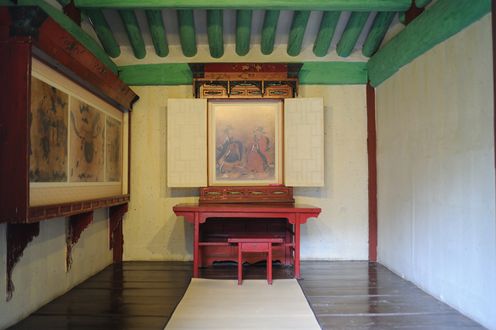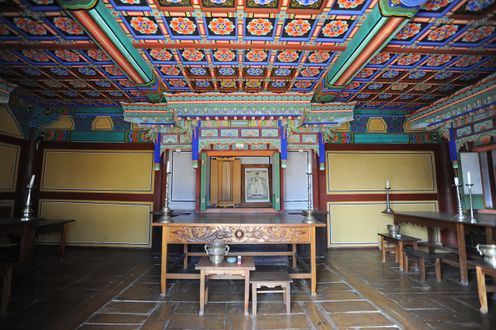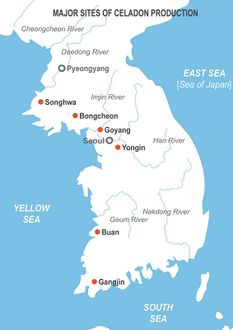"The Revival of Goguryeo - Goryeo"의 두 판 사이의 차이
| (같은 사용자의 중간 판 2개는 보이지 않습니다) | |||
| 3번째 줄: | 3번째 줄: | ||
}} | }} | ||
| − | <gallery mode=packed heights= | + | Goryeo emerged during the declining period of [[Silla]]. Founded in 918 by [[Wang Geon]] as the symbolic successor state of [[Goguryeo]], it united the [[Three Kingdoms Period|Later Three Kingdoms]] in 936. Its territory included all but the northernmost part of the Korean peninsula. In the late 10th and early 11th centuries, Goryeo was invaded multiple times by the neighboring Khitan Liao Dynasty, which was threatened by Goryeo's relation with Song China, but Goryeo was victorious. Goryeo then experienced a century and a half-long golden age until 1170 when a military regime took over. Beginning in 1231, the Mongols invaded Goryeo multiple times. After decades of successful resistence, Goryeo became a subordinate but autonomous state of the Yuan Dynasty in 1270. While under the Mongol sphere of influence, Goryeo princes married Mongol princesses, while Mongol princes married Goryeo princesses, created highly interwind Goryeo-Yuan royal families. Goryeo regained its autonomy in the mid-14th century, but ended shortly thereafter in 1392 with the establishment of the [[Joseon]] dynasty. In total, the Goryeo dynasty lasted 474 years. |
| + | |||
| + | From its foundation, Goryeo adopted many Confucian institutions, such as the civil service examination, while keeping Buddhism as the state religion. During the dynasty's Golden Age, the [[Tripitaka Koreana]], a collection of over 80,000 woodblocks of the Buddhist scriptures, was created. This period also saw the creation of the first [[movable metal type]] capable of printing books and the oldest extant movable metal type book, the [[Jikji|''Anthology of Great Buddhist Priests' Zen Teachings'', i.e. ''Jikji'']]. Goryeo was well known for its [[Goryeo celadon|celadon]], which was exported widely outside the peninsula. Foreign merchants spread word about "Goryeo" to the rest of the world, which is how the West came to call the country "Korea." | ||
| + | |||
| + | <gallery mode=packed heights=220px> | ||
| + | 파일:1-9.고려 공민왕 사당 DSC_7610.jpg|Shrine for King Gongmin of Goryeo (Hunjeong-dong, Jongno-gu, Seoul) | ||
| + | 파일:1-9.고려 숭의전-ESC_8725.jpg|Sungeuijeon Hall of Goryeo (Sungeuijeon-no, Misan-myeon, Yeoncheon-gun, Gyeonggi-do) | ||
| + | 파일:1-9.고려 숭의전-ESC_8734.jpg|Sungeuijeon Hall of Goryeo (Sungeuijeon-no, Misan-myeon, Yeoncheon-gun, Gyeonggi-do) | ||
| + | 파일:1-9.고려 숭의전-ESC_8736.jpg|Sungeuijeon Hall of Goryeo (Sungeuijeon-no, Misan-myeon, Yeoncheon-gun, Gyeonggi-do) | ||
| + | 파일:1-9.공양왕릉-DSC_8863.jpg|Royal Tomb of King Gongyang (Wondang-dong, Deokyang-gu, Goyang, Gyeonggi-do) | ||
| + | 파일:2-6.고려궁터-ESC_8962.jpg|Main Gate of the Reconstructed Goryeo Palace on Ganghwado Island (Gwancheong-ni, Ganghwa-eup, Ganghwa-gun, Incheon) | ||
| + | </gallery> | ||
| + | |||
| + | <gallery mode=packed heights=220px> | ||
File:007(E).jpg|Goryeo | File:007(E).jpg|Goryeo | ||
File:024(E).jpg|Goryeo International Trade | File:024(E).jpg|Goryeo International Trade | ||
2017년 11월 23일 (목) 10:48 기준 최신판
Goryeo emerged during the declining period of Silla. Founded in 918 by Wang Geon as the symbolic successor state of Goguryeo, it united the Later Three Kingdoms in 936. Its territory included all but the northernmost part of the Korean peninsula. In the late 10th and early 11th centuries, Goryeo was invaded multiple times by the neighboring Khitan Liao Dynasty, which was threatened by Goryeo's relation with Song China, but Goryeo was victorious. Goryeo then experienced a century and a half-long golden age until 1170 when a military regime took over. Beginning in 1231, the Mongols invaded Goryeo multiple times. After decades of successful resistence, Goryeo became a subordinate but autonomous state of the Yuan Dynasty in 1270. While under the Mongol sphere of influence, Goryeo princes married Mongol princesses, while Mongol princes married Goryeo princesses, created highly interwind Goryeo-Yuan royal families. Goryeo regained its autonomy in the mid-14th century, but ended shortly thereafter in 1392 with the establishment of the Joseon dynasty. In total, the Goryeo dynasty lasted 474 years.
From its foundation, Goryeo adopted many Confucian institutions, such as the civil service examination, while keeping Buddhism as the state religion. During the dynasty's Golden Age, the Tripitaka Koreana, a collection of over 80,000 woodblocks of the Buddhist scriptures, was created. This period also saw the creation of the first movable metal type capable of printing books and the oldest extant movable metal type book, the Anthology of Great Buddhist Priests' Zen Teachings, i.e. Jikji. Goryeo was well known for its celadon, which was exported widely outside the peninsula. Foreign merchants spread word about "Goryeo" to the rest of the world, which is how the West came to call the country "Korea."









